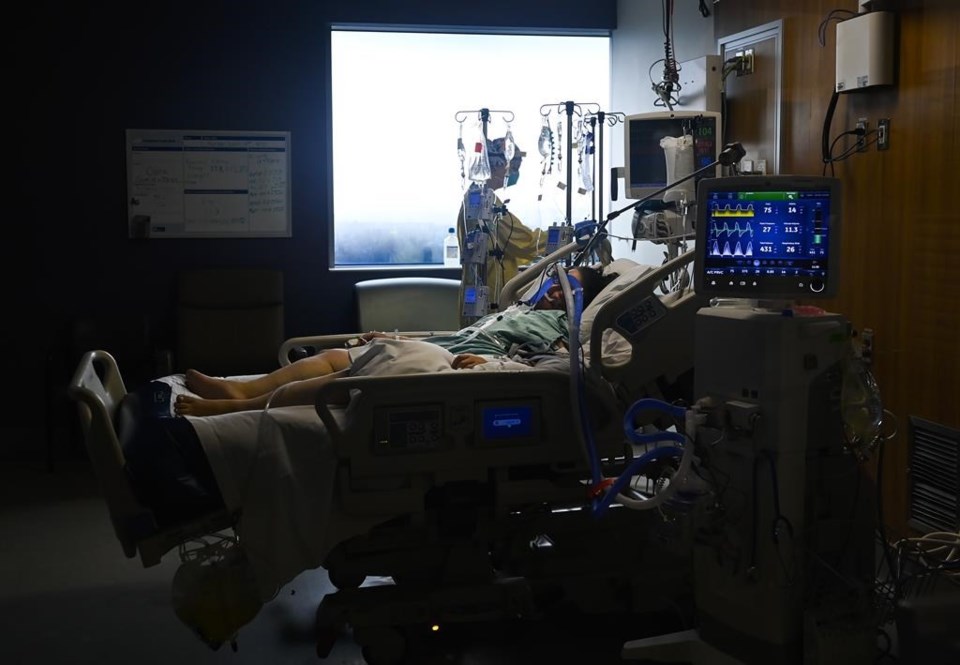TORONTO — It may be harder for Ontario's health system to quickly respond to a surge in critically ill COVID-19 patients as non-virus care ramps up and workers contend with burnout, according to a new report that recommends sustained public health measures to preserve hospital capacity.
The report on critical care capacity from the Ontario COVID-19 Science Advisory Table was published Tuesday as the province logged 153 patients in intensive care units.
Researchers found that co-ordination across the health system during the first three waves of the pandemic – which involved nearly 1,000 patient transfers, redeploying staff and ramping down non-urgent surgeries – helped avoid the worst case scenario of critical care triage.
But the province is now prioritizing non-COVID procedures that have been delayed and staff who haven't left the workforce are burnt out and dealing with higher workloads, said Dr. Kali Barrett, a critical care physician who was the lead researcher on the study.
That means the health system can still respond, but without some of the same flexibility available in previous waves, she said.
"We made it through the previous waves and we were there for the needs of the Ontario public, and our priority and our goal will be to do the same ... but it would be harder in a successive time," Barrett said.
Among other factors, the report also highlighted "a near complete absence" of influenza transmission during the last flu season, likely due to COVID-related public health measures, which helped free up intensive care space. Recent projections indicate that won't be the case this year, the report said, so the flu may sicken more people this coming winter.
The report also examined peak periods of intensive care occupancy during the pandemic. The first wave saw a lower-than-average number of patients in intensive care, and the second and third waves saw numbers "well above" historical averages for intensive care occupancy. At the peak of the third wave, the number of patients on ventilators in Ontario was at 180 per cent of the pre-pandemic historic average.
The fourth wave, as of Oct. 31, has seen a "stable" number of admissions and a "less pronounced peak," the report said, though it noted that patients in hospital are more acutely ill and more require mechanical ventilation than in non-pandemic years.
Barrett said patients on ventilators are the "sickest in ICUs," requiring more staff to care for them.
Public health measures are necessary to keep COVID-19 and influenza cases low, the report said, and it called for longer-term measures to tackle staffing challenges, though it noted that current data on the scope of the problem is lacking.
Barrett said people should continue to get vaccinated, minimize virus exposure risk and avoid prolonged indoor contact with crowds. Lifting restrictions also isn't advised.
"This would not be the time to pursue sort of any relaxation of public health measures," she said. "Given also the uncertainty that we have right now with the new variant, I think there's just so much unknown, that we just need to continue to play it very safe."
Modelling from science table has indicated that the number of patients in intensive care may rise to 200 by the new year. The province's top doctor has also said he expects COVID-19 cases to continue rising through the winter.
But Dr. Kieran Moore and government ministers have said the province will wait learn more about the new Omicron variant of concern – of which four cases have been reported in Ontario – before pausing plans to start lifting more public health restrictions as early as January.
The CEO of the Ontario Hospital Association said Tuesday that the report speaks to the "sacrifices and tough decisions" that have been made in hospitals over the last two years to fight COVID-19.
Things have stabilized since there were more than 900 critically ill COVID-19 patients in Ontario hospitals this spring, but Anthony Dale said the health system can't be taken for granted.
"This is so far from normal, even now. I think people are getting used to it, and they should not get used to this at all," Dale said in an interview. "Our whole hospital sector is very, very fragile at the moment."
With about 14 per cent of the Ontario population over age 12 not fully vaccinated, Dale said increased pressure on critical care services is "inevitable." He urged people who haven't yet been vaccinated to get their shots.
"The future hasn't happened yet and we have within our hands the power to greatly mitigate against the risk of Delta and Omicron ... and that's the most powerful weapon in our arsenal," he said.
This report by The Canadian Press was first published Nov. 30, 2021.
Holly McKenzie-Sutter, The Canadian Press

